The Problem with Education Technology (Hint: It’s Not the Technology)
by Ben Fink and Robin Brown
FrameMaker – Creating and Publishing Content
by Matt R. Sullivan
Revitalising Audience Research: Innovations in European Audience Research
by Frauke Zeller, Cristina Ponte, and Brian O’Neill, eds.
The Cybrarian’s Web 2: An A–Z Guide to FREE Social Media Tools, Apps, and Other Resources
by Cheryl Ann Peltier-Davis
Rethinking Post-Communist Rhetoric: Perspectives on Rhetoric, Writing, and Professional Communication in Post-Soviet Spaces
by Pavel Zemliansky and Kirk St.Amant, eds.
Graphic Design Visionaries
by Caroline Roberts
Mapping Experiences: A Guide to Creating Value through Journeys, Blueprints, and Diagrams
by James Kalbach
Essays on Technical Writing
by Geoffrey Marnell
Critical and Creative Thinking: A Brief Guide for Teachers
by Robert DiYanni
Routledge Handbook of Public Communication of Science and Technology, 2nd ed.
by Massimiano Bucchi and Brian Trench, eds.
The Routledge Handbook of Environment and Communication
by Anders Hansen and Robert Cox, eds.
The Accidental Taxonomist, 2nd ed.
by Heather Hedden
Restricted Access: Media, Disability, and the Politics of Participation
by Elizabeth Ellcessor
Experience Required: How to become a UX leader regardless of your role
by Robert Hoekman, Jr.
Literacy in Practice: Writing in Private, Public, and Working Lives
by Patrick Thomas and Pamela Takayoshi, eds.
The New Normal: Pressures on Technical Communication Programs in the Age of Austerity
by Denise Tillery and Ed Nagelhout, eds.
International Virtual Teams: Engineering Global Success
by Pam Estes Brewer
The International History of Communication Study
by Peter Simonson and David W. Park, eds.
Communication and Emerging Media: What’s Trending Now
by Carie S. Lambert and Maribeth Schlobohm
Organizing Ideas: The Key to Effective Communication
by Matthew Spence
Muse of Fire: Storytelling & The Art of Science Communication
by Tim Miller
The Graphic Design Idea Book: Inspiration from 50 Masters
by Stephen Heller and Gail Anderson
Research for Designers: A Guide to Methods and Practice
by Gjoko Muratovski
Photoshop Tricks for Designers: How to Create Bada$$ Effects in Photoshop
by Corey Barker
The Problem with Education Technology (Hint: It’s Not the Technology)
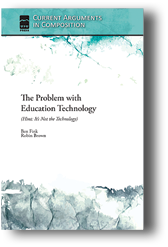 Ben Fink and Robin Brown. 2016. Boulder, CO: Utah State University Press. [ISBN 978-1-60732-446-1.46 pages. USD$6.99 (softcover).]
Ben Fink and Robin Brown. 2016. Boulder, CO: Utah State University Press. [ISBN 978-1-60732-446-1.46 pages. USD$6.99 (softcover).]
Fink and Brown’s thin volume is written so well that reading it a second time is as interesting and engaging as the first. With lines like, “What is a ‘paper,’ exactly? Just like pornography: you know it when you see it,” who would stop? (p. 24). While their text touches on multiple topics at the intersection of writing and technology, the volume’s emphasis centers on Automatic Essay Scoring (AES). Fortunately, the authors do not focus just on the artificial nature of AES grading—they move past that and land on the artificial nature of many writing assignments as well as human-based scoring approaches—particularly as they manifest in high-stakes tests like the GRE and SAT.
Their core argument has several pieces. Primarily, machines cannot read and evaluate like experts; instead, the systems only find the signifiers or variables that they are told experts seek as indicators of writing capacity and ability. This claim gains power when the authors hone in on the Education Technology Services (ETS) raters take by focusing on the essay’s form rather than their claims or arguments. This is done with human raters, the authors point out, and that is key to the problem of AES and automation. “The problem with the machine isn’t about the machine. It’s about how humans (in this case, standardized test raters) got turned into machines. And how these mechanized humans became accepted as the ‘experts’ for the machines to (easily) emulate” (p. 12).
The text is accessible, friendly, and familiar—especially for writers or writing teachers. It floats lightly and deftly. Unfortunately, the authors employ a straw man: Massive Open Online Courses (MOOCs). Discussing mostly the profit and student extraction aspects of MOOCS and the role that AES has in them offers a limited view. Sadly, they overlook writing which takes place in MOOCs: forums, messaging, and social media. This writing is neither easy to track or evaluate; pretending that this real writing for real audiences does not emerge in many MOOCs is problematic. Equally problematic is ignoring MOOCs like #clMOOC where goals are explicitly around professional development and multimedia authoring; lifelong learning, not the degree, drive those MOOCs. MOOCs are not the enemy. The desire to extract profit and capitalize on every possible interaction with students should remain the authors’ target. Automatic grading enables such extraction and increases profits for academic administrations and the EdTech companies they hire.
The Problem with Education Technology ends with hope. It centers on the importance of organizing with groups beyond writing teachers. The goal is to limit the juggernaut of high stakes testing—a powerful force that is helping fund, in terms of political clout, time, and money—a juggernaut that is increasingly reliant upon the automatonic grading (by humans or computers) of writing which should be, in stark contrast, thoughtful, powerful, engaging, and not limited to a select set of structural and rhetorical moves.
Gregory Zobel
Gregory Zobel is an assistant professor of Educational Technology at Western Oregon University.
FrameMaker – Creating and Publishing Content
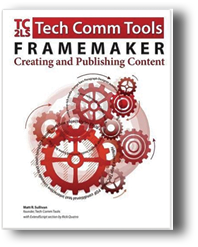 Matt R. Sullivan. 2015. San Juan Capistrano, CA: Tech Comm Tools. [ISBN 978-0-9967157-9-9. 592 pages, including index. USD$49.99 (softcover).]
Matt R. Sullivan. 2015. San Juan Capistrano, CA: Tech Comm Tools. [ISBN 978-0-9967157-9-9. 592 pages, including index. USD$49.99 (softcover).]
Being a bit selfish, I picked this book to review as I don’t have a reference book at home on FrameMaker and have thought at times it would be nice to have one. This points out that the book has a market as I am part of that market. Plus, while not minding to brush up on FrameMaker by Googling videos and online text, I have thought it would be good to have a reference book on paper, too.
With an impressive scope and weighing in at what feels like at least a pound, FrameMaker – Creating and Publishing Content should prove to be the reference I have wanted.
New users can be one audience for the book as can be more experienced users who want a reference. Sullivan addresses newer technologies like Kindle, EPUB, and HTML5, and the FrameMaker options for handling multi-channel outputs. My interest so far is in more traditional uses for FrameMaker, yet it is good to have these options covered, too.
The section on working with a table of contents proved especially helpful and informative. Since I do not work with FrameMaker on a daily basis, when I do use it, having this reference even on the basics of a table of contents makes it worth owning. A good example of the kinds of tips offered include working with a table of contents is, “If you have two TOC reference page entries in the file, FrameMaker uses the one it finds first. If you update the book but do not see an updated TOC, check the reference pages for an extra TOC text frame” (p. 349).
Jeanette Evans
Jeanette Evans is an STC Associate Fellow and active in the NEO community, currently serving on the newsletter committee. She holds an MS in technical communication management from Mercer University. Jeanette has published an article, “Emerging Technologies: Where We Have Been and Where We Are Going” in STC’s Intercom magazine.
Revitalising Audience Research: Innovations in European Audience Research
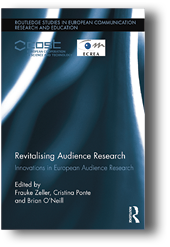 Frauke Zeller, Cristina Ponte, and Brian O’Neill, eds. 2015. New York, NY: Routledge. [ISBN 978-1-138-78737-7. 294 pages, including index. US145.00.]
Frauke Zeller, Cristina Ponte, and Brian O’Neill, eds. 2015. New York, NY: Routledge. [ISBN 978-1-138-78737-7. 294 pages, including index. US145.00.]
This is the fifth book in the Routledge Studies in European Communication Research and Education series. Like the other four, its many authors hail from a number of countries, but all write in English. Revitalising Audience Research: Innovations in European Audience Research presents reports on 20 studies about various aspects of audience research, each written by the study authors themselves. The final chapter by one of the book’s editors, Frauke Zeller, offers a critical perspective on big data in audience research.
The topics cover a variety of narrowly focused projects, from ethnographic research into online gamers’ behavior in the game and in real life, to the reasoning of young people who are not using social networking sites, to a linguistic perspective on how group identities are constructed in online discussions. Some of the research seems a bit dated, such as a project about Second Life, an online role playing game my now-adult son played in middle school, or one that explored Finland’s move to digital-only television—a change now replicated in a number of countries, including the US.
As one might expect from such a variety of authors, the writing ranges from relatively accessible to lay people to difficult to understand for those outside the narrow specialization covered by the particular chapter. The book is marketed as a text book. Its intended audience is therefore likely more familiar with audience research as a specific field of inquiry than I (a media studies major who focused on how news is presented, not how the reader perceives it) am.
Frankly, I needed to read subtitles such as “The Use of Q Methodology to Fuse Quantitative and Qualitative Approaches for Increased Explanatory Power in Comparative Research” more than once before I knew what the subject of that chapter was. In case you are interested, Q methodology is a research method for assessing a person’s viewpoint, and the authors combined interviews with having interviewees sort standardized cards onto a grid and then mathematically analyzed the outcome of that task. They did this with people in Flanders, Belgium, and Denmark to explain how news is consumed in these two areas of Europe.
If you are a student or professor in audience research or a closely related field, you may find Revitalising Audience Research helpful. If you are not, it may prove a bit overwhelming, and probably not all that useful.
Barbara Jungwirth
Barbara Jungwirth owns reliable translations llc (www.reliable-translations.com), where she translates technical documents from German into English. She was previously a technical writer and IT manager and currently serves on the board of STC’s New York Metro chapter. Barbara writes a blog (On Language and Translation) and tweets (@reliabletran).
The Cybrarian’s Web 2: An A–Z Guide to FREE Social Media Tools, Apps, and Other Resources
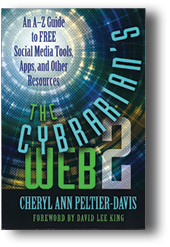 Cheryl Ann Peltier-Davis. 2015. Medford, NJ: Information Today, Inc. [ISBN 978-1-57387-512-7. 354 pages, including index. USD$49.50 (softcover).]
Cheryl Ann Peltier-Davis. 2015. Medford, NJ: Information Today, Inc. [ISBN 978-1-57387-512-7. 354 pages, including index. USD$49.50 (softcover).]
The Cybrarian’s Web 2: An A-–Z Guide to Free FREE Social Media Tools, Apps, and Other Resources, a follow-up to The Cybrarian’s Web (2012), is a handy guide to social media tools, apps, and other resources that belongs on every librarian’s bookshelf. Librarians can use this guide to make the best use of social media tools, expand services for their patrons, and better market those services to the public. The wide range of resources described makes it appropriate for all types of libraries and even non-library environments.
The 61 chapters are arranged alphabetically by resource name with each chapter containing an overview, list of features, and a description of how cybrarians can use the resource. Many chapters also feature For Your Information (FYIs) that highlight useful information tidbits.
The average reader may be familiar with some of the resources, which include eBooks, cloud storage/file hosting/sharing, photo/video sharing, and Microsoft Office Online. The library’s expanding role in the 21st century is reflected in resources such as Makerspaces and Self-Publishing Platforms. Other tools such as augmented reality/wearable technology and Quick Response (QR) code scanners/generators use the latest advances in information technology.
The Cybrarian’s Web 2 also contains several useful appendices. Appendix IV gives access to the tools by service type. Other appendices contain tips for keeping up with emerging technologies, a glossary of resources, referenced websites, and tool availability by mobile device. The excellent index also assists the reader in finding desired information.
This book is easy to use and clearly written. Though it would be impossible to outline every tool and resource available, the wide range highlighted here offers something to nearly everyone. I would recommend it to all information professionals in a variety of settings, both for work and personal use.
Jennifer Spanier
Jennifer Spanier has been a freelance book and database indexer since 2009 and is an active member of the American Society for Indexing. Previously she has worked as a biologist and a public librarian and indexes in a wide variety of subject areas.
Rethinking Post-Communist Rhetoric: Perspectives on Rhetoric, Writing, and Professional Communication in Post-Soviet Spaces
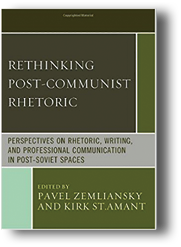 Pavel Zemliansky and Kirk St.Amant, eds. 2016. Lanham, MD: Lexington Books. [ISBN 978-1-4985-2337-0. 238 pages, including index. US$90.00.]
Pavel Zemliansky and Kirk St.Amant, eds. 2016. Lanham, MD: Lexington Books. [ISBN 978-1-4985-2337-0. 238 pages, including index. US$90.00.]
We are familiar with the economic and political differences between the Union of Soviet Socialist Republics (USSR) and the West. But, how different are these theories after the break up of the Soviet Bloc with these states moving toward a more Western approach? Do those differences exist in education, specifically how students are taught to write?
Zemliansky and St.Amant’s collection, Rethinking Post-Communist Rhetoric: Perspectives on Rhetoric, Writing, and Professional Communication in Post-Soviet Spaces, attempts to answer that question. The editors’ Introduction provides an overview for the essays by telling us that there are four contexts discussed in the essays: classroom, where people work, teaching in global contexts, and using different media. Likewise, the essays cover three areas: rhetoric, writing, and communications. So, the target audience includes researchers, teachers, and students
In 10 essays, the authors address these topics: writing instruction in Russia and Ukraine (Essay 1); a writing center at a Moscow university (2); the current state of technical communication education in Russia (3); Russian education and the global community (4); technical communication rhetoric in Europe and the USA (5); documentation requirements in Russia and the USA (6); technical communication programs in the former German Deutsche Demokratische Republik (GDR) (7); Serbia and the Bologna Process (a set of reforms to standardize European higher education) (8); cross-cultural collaboration in the Ukraine (9); and social media use in Russia (10).
While the collection will appeal to educators, professional technical communicators can find useful information, especially if they specialize in localization or their organizations regularly deal with post-Soviet countries. The more that we understand about the culture and environments of these countries, the better able we will be to communicate effectively with them. In this case, understanding how our users have learned to communicate in writing, the more effective will be our communications. For communication teachers who have international students in their classes from these countries, knowing how they were trained can ease the transition between rhetoric as practiced in the post-Soviet countries and as practiced in the West.
My major disappointment in these essays is that none, even in the Introduction, address the contributions of INTECOM, an organization of technical communication organizations, and especially the work done by the German society tekom (other than in Essay 7). INTECOM’s work in the late 1990s and early 2000s did much to influence the way technical communication works worldwide. Through symposia such as FORUM and the panel discussions with Russian and Chinese writers, member societies were able to help spread the way writing was practiced and taught in the West.
In the concluding paragraph of their introduction, the editors suggest a path forward for the readers. Had they offered their own conclusions in an ending essay (an 11th essay), the collection would offer a significant starting point for teachers and students.
In spite of my reservations, however, I would recommend this collection for libraries and advanced classes in rhetorical and cross-cultural pedagogy.
Tom Warren
Tom Warren is an STC Fellow, Jay R. Gould Award for Excellence recipient, and professor emeritus of English (technical writing) at Oklahoma State University, where he established the BA, MA, and PhD technical writing programs. Past president of INTECOM, he served as guest professor at the University of Paderborn, Germany.
Graphic Design Visionaries
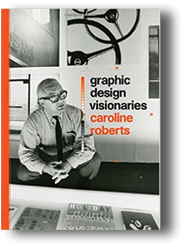 Caroline Roberts. 2015. London, England: Laurence King Publishing. [ISBN 978-1-78067-484-1. 312 pages, including index. US$40.00 (softcover).]
Caroline Roberts. 2015. London, England: Laurence King Publishing. [ISBN 978-1-78067-484-1. 312 pages, including index. US$40.00 (softcover).]
Graphic Design Visionaries is a fantastic accompaniment to any required graphic design history text. This book features 75 designers/design teams and is organized by date of birth, instead of alphabetically as one might expect. This gives the text the sense of being chronological, but as any history text it is difficult to maintain since many events, or in this case people, overlap one another. Each designer or design team is highlighted in two, two-page spreads (for a total of four pages) that includes a brief biography and background information on the designer/s as well as multiple examples of their work and a timeline of significant events in the designers’ careers. The dates of the designers covered in the text range from those active in the early 1900s to current designers.
Roberts addresses the concern of an established canon of graphic designers in the introduction, explaining that this is a starting point and therefore is “very much on the established canon” (p. 7). She goes on to explain the narrow field of graphic design participants historically, thus forcing this demographic. However, Roberts expresses hope for the future by conveying the rise in women who are enrolled in graphic design schools specifically, and she goes on to express hope for wider demographics in future editions.
Despite Roberts’ admission, you sense that she is trying to move beyond the canon, with the inclusion of not-often referenced designers from Brazil, Japan, and Spain. Graphic Design Visionaries also starts the expansion on the current canon of graphic design by giving the same amount of space for images and copy to all the designers in the book. She also expands the canon by including designers such as Lora Lamm who was “one of a number of Swiss designers to flock to Milan . . . but unlike such contemporaries as Max Huber, Walter Ballmer and Carlo Vivarelli, Lamm was somehow written out of the canon of design history” (p. 161).
The examples shown from each designer are another refreshing item in Graphic Design Visionaries. Many images shown are varied from the typical images that are shown in standard textbooks. While Roberts has carefully chosen accompanying images that are not often used in principal texts, such as some iconic designs that may have helped established the designer in terms of style or notoriety, those in the field cab understand why these cannot be left out because they are historically significant in the designers’ careers.
It is understandable that it is impossible for any general history textbook to include all information on a subject; they must include a range of subjects from people, events and technology. Therefore, there are ways to complement the designers’ content to gain a broader understanding of history. Including Graphic Design Visionaries as a supplement is a must to understand the lives and careers of influential designers in the history of graphic design.
Amanda Horton
Amanda Horton holds an MFA in Design and currently teaches graduate and undergraduate courses at the University of Central Oklahoma in the areas of design technology, design studio and history of graphic design. She serves as a book reviewer for Technical Communication.
Mapping Experiences: A Guide to Creating Value through Journeys, Blueprints, and Diagrams
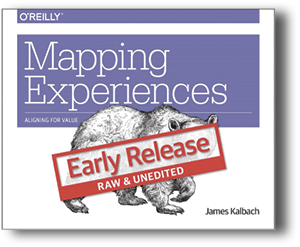 James Kalbach. 2016. Sebastopol, CA: O’Reilly Media. [ISBN 978-1-4919-2353-9. 362 pages, including index. US$34.99 (softcover).]
James Kalbach. 2016. Sebastopol, CA: O’Reilly Media. [ISBN 978-1-4919-2353-9. 362 pages, including index. US$34.99 (softcover).]
Mapping Experiences: A Guide to Creating Value through Journeys, Blueprints, and Diagrams explores a little-understood topic within user experience (UX): how to create usable, useful maps that entire organizations can use to align their goals with their customers’ experiences. A journey map has long been a tool of the trade in UX. Organizations frequently use them to depict a customer’s journey from first discovering their brand to making a purchase. Mapping the buying experience helps the organization identify problems in the customer journey.
In Mapping Experiences, Kalbach takes this approach to a new level by introducing a method for mapping all the experiences an organization creates, from the point of view of both internal stakeholders and customers. For Kalbach, mapping experiences in a holistic fashion helps alleviate “transitional volatility,” or the inconsistency customers experience across various touchpoints (p. 21). Such maps can “provide a systematic overview of the experiences you create” (p. 20). Furthermore, “By fostering conversations across the organization, the process of mapping helps avoid negative transitional volatility and promote coherency” (p. 20).
The main method for mapping experiences that Kalbach introduces that is new to the conversation is what he calls an “alignment diagram,” or “any map, diagram,
or visualization that reveals both sides of value creation in a single overview” (p. 4). This is Kalbach’s attempt to systematize what has long been a haphazard UX process: diagramming how business goals and user goals meet, or fail to. By focusing on the concept of alignment, Kalbach ingeniously pushes the conversation toward aligning the values that companies create with the values that their customers create.
Mapping Experiences is a how-to guide for everything map-related, but it is also an approach that goes beyond the simple journey map. After introducing the concept of mapping experiences in Chapters 1–3, Kalbach provides a robust process for developing various elements of maps, including choosing an overall orientation for the map, conducting research, illustrating, aligning values, and thinking about future experiences (Chapters 4–8). He closes the book with a deeper dive into four specific types of maps: service blueprints, customer journey maps, experience maps, mental model maps, and models for entire ecosystems (Chapters 9–12).
A great book for novices and seasoned mappers alike, Mapping Experiences is for anyone who has ever struggled to depict a complex process or system from a single viewpoint. It is loaded with valuable advice on everything from point-of-view to visual specificity and represents a definite step forward in the evolution of mapping as a useful method for improving user experiences.
Guiseppe Getto
Guiseppe Getto is a faculty member at East Carolina University. He is also President and Co-Founder of Content Garden, Inc., a digital marketing and UX consulting firm.
Essays on Technical Writing
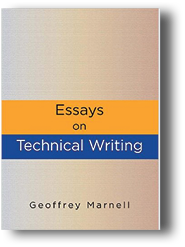 Geoffrey Marnell. 2016. Brighton, Victoria, Australia: Burdock Books. [ISBN 978-0-994-36667-2. 256 pages, including index. US$19.99 (softcover).]
Geoffrey Marnell. 2016. Brighton, Victoria, Australia: Burdock Books. [ISBN 978-0-994-36667-2. 256 pages, including index. US$19.99 (softcover).]
Essays on Technical Writing is a collection of papers and articles previously written by Marnell and now collected in one place. As the name suggests, this book gives discussions and musings on a number of different technical writing topics. Some essays, such as “Chapter 10: A Lament for the Vanishing Index,” seem to be more like lengthy discussions on a topic that might be of interest to those new to the field of technical writing. Other essays, such as “Chapter 13: Font Choice and Waste,” could be helpful practical advice for new technical writers. This book could also be a great tool for fostering discussion in an introductory-level technical writing class, as it covers a wide range of topics from the name of the field (technical writing) to writing for international readers. The essays listed could be great starting places for students to learn that there is more to technical writing than just editing or writing manuals.
The book has a nicely detailed index, which could certainly be useful in determining where to look for concepts not listed in the table of contents. One feature that the book currently lacks is an Introduction, leaving the reader to figure out through textual cues that this is, in fact, a book of somewhat unrelated essays by the same author that were previously published in other locations. It would seem that letting readers know what they were about to encounter would be helpful to ensure that readers would understand that there is no new work from Marnell in this book.
Overall, the book, while not being overly technical in nature, could be a good starting point for people looking to learn more about what actually goes on in technical writing. It could also be helpful in explaining some of the nuances of the field that technical writers might not often think about.
Laura Dumin
Laura Dumin has been teaching in technical writing for over 10 years and is an Assistant Professor and the Director of Technical Writing at the University of Central Oklahoma.
Critical and Creative Thinking: A Brief Guide for Teachers
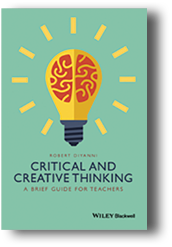 Robert DiYanni. 2016. Malden, MA: John Wiley & Sons, Inc. [ISBN 978-1-118-95537-6. 264 pages, including index. US$69.95.]
Robert DiYanni. 2016. Malden, MA: John Wiley & Sons, Inc. [ISBN 978-1-118-95537-6. 264 pages, including index. US$69.95.]
Although, as the title states, this book is directed toward teachers, while I was reading it, I kept thinking that this is too narrow an audience. Anyone who wants to challenge their brains to engage in “whole-minded thinking to generate new ideas” (p. xi) will benefit from Robert DiYanni’s Critical and Creative Thinking: A Brief Guide for Teachers. In it, he imparts general guidelines and specific techniques for developing critical and creative capacities.
DiYanni’s premise is that critical thinking, while valuable, is not enough to generate and evaluate new ideas. Creative thinking combined with critical thinking is what “eliminates bad thinking habits” and leads to thinking well. He supplements his own writing on this topic with examples from “a wide range of sources” (p. xii). Critical and Creative Thinking “explains a set of approaches and offers a series of opportunities to think about a wide range of issues and topics” (p. xi). The book is, to a large extent, a survey of other books that enlarge on these approaches and opportunities.
Essential concepts of critical and creative thinking are the subject of Part One. Each type of thinking is dissected separately to identify what is involved. To think critically, one must purposefully analyze, evaluate, apply knowledge, reflect, and so on. Creative thinking, on the other hand, is imaginative, seeking alternatives, shifting focus, and maintaining curiosity, among other elements. An important feature of Critical and Creative Thinking appears at the end of each chapter: practice questions that provide a thorough review and further probing of the issues addressed. They are intended not only for the reader but also for students in the case of a reader who is a teacher.
Part Two looks at other ways in which critical thinking and creative thinking are practiced. DiYanni goes into detail about language and thought before looking again at ways of practicing creative thinking and strategies for critical thinking, as well as at guidelines for generating ideas. He finds examples to illustrate his points in surprising (and interesting) places, from hot-dog eating contests to Sister Act. In Part Three, applications of critical and creative thinking extend to making decisions and ethical choices. A brief discussion of ethics and technology, including privacy, ownership of digital information, and dating websites, seems timely and may especially interest students of those who use this book for teaching. It could have been discussed in more depth.
The ideas in Critical and Creative Thinking are not groundbreaking, especially if you already agree with DiYanni’s premise. Some of it is repetitive. But it is a thought-provoking book in many ways and provides noteworthy examples of ways in which people have applied thinking techniques to come up with solutions to problems. The bibliography of source material is also valuable. As a footnote, there is a companion website, and DiYanni offers lesson plans through this online resource.
Linda Davis
Linda M. Davis is an independent communications practitioner in the Los Angeles area. She holds an MA in Communication Management and has specialized in strategic communication planning, publication management, writing, and editing for more than 25 years.
Routledge Handbook of Public Communication of Science and Technology
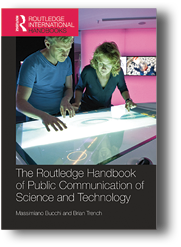 Massimiano Bucchi and Brian Trench, eds. 2014. 2nd ed. New York, NY: Routledge. [ISBN 978-0-415-83461-2. 258 pages, including index. US$215.]
Massimiano Bucchi and Brian Trench, eds. 2014. 2nd ed. New York, NY: Routledge. [ISBN 978-0-415-83461-2. 258 pages, including index. US$215.]
The Routledge Handbook of Environment and Communication
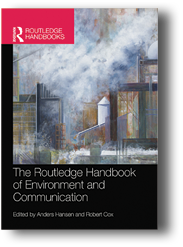 Anders Hansen and Robert Cox, eds. 2015. New York, NY: Routledge. [ISBN 978-0-415-70435-9. 434 pages, including index. US $278.]
Anders Hansen and Robert Cox, eds. 2015. New York, NY: Routledge. [ISBN 978-0-415-70435-9. 434 pages, including index. US $278.]
Routledge Handbook of Public Communication of Science and Technology, Second Edition is a superb collection of articles covering contemporary issues in science communication. The book’s theme is society’s relationship with science and the many factors that influence and complicate this relationship. The collection emphasizes such contemporary issues as publics and their understanding of and participation in science; the roles of science and scientists in public policy; the popularization of science; communicating risk, trust, and uncertainty in science and technology; the changing landscape of science and science communication in a digitized world; and issues of globalization and science communication. The authors include special chapters on health, social science, and environmentalism. Even though this is an edited collection of articles from 22 different authors, there is uniformity among the chapters making the reading easy to follow. Each chapter addresses the history, current state, and controversies of an issue related to communicating science and technology followed by deliberations on its future. Discussion questions finalize each chapter.
Similarly, The Routledge Handbook of Environment and Communication is a collection of works devoted to the environment, one of the top critical global concerns today. This book is a multidisciplinary and international assembly of works that explore, theorize, and examine core concepts in environment and communication that “can help, not only to understand the centrality of communication processes and communications media in the public sphere, but political definition, elaboration and contestation of environmental issues and problems” (p. 1). Divided into five parts, the authors cover historical aspects of the field, producing environmental communication, coverage of the environment through news and entertainment media, social and political implications of environmental communication, and the future of environmental communication. Subcategories within each part of the book, along with uniformity and consistent length of the chapters, makes the collection cohesive. One strength is the book’s breadth of content, as there is something for any reader intrigued by this topic.
Each book can stand on its own as a reputable scholarly work intended for scientists, science communicators, and practitioners (for example, government employees), educators, and students in environmental, science, and communication programs; however, the two books actually complement each other. For instance, some topics are the same or similar, and reading both books gives readers a more diverse, comprehensive understanding of a topic. Climate change is just one example. In Public Communication of Science and Technology, Nisbet discusses some reasons Americans disagree about the science and proposed solutions regarding climate change. Interestingly, research showed that science is not the root of disagreement—but social and political identities are major factors in how individuals view climate change. Along those same lines, Miller and Dinan in The Handbook of Environment and Communication discuss various perspectives on climate change, including the contrarian view that basically denies climate change and/or its contributing factors. The historical look at the manufacture of the contrarian view gives readers a corporate perspective that could very well inform their social identity and political loyalties. Additional chapters in each book also address issues associated with climate change that widen readers’ understanding of the contention behind this issue.
Science’s popularization is another theme that runs through both books. In The Handbook of Environment and Communication, Dunwoody offered a brief history of the tense relationship between the scientific community as a whole and scientists who publically communicate their work and cooperate with journalists. This relationship had and continues to have an impact on public understanding and views of science, scientists, the environment, and more. Likewise, in Public Communication of Science and Technology, there are several chapters that address the popularization of science in society, such as the evolution of science books (Bell & Turney); the making of science celebrities like Stephen Hawking, Carl Sagan, and Richard Dawkins (interestingly, not many women make it into this category) (Fahy & Lewenstein); and science, scientists, and scientific research in popular films today (Kirby).
Other common themes include public perception and participation in environmental issues in science and technology, the media’s role in reporting on the environment and topics in science and technology, changes in environmental and science journalism due to advances in communication technology, and impacts of globalization on communication of the environment, science, and technology. While some overlap exists on these issues in both books, there is enough difference in content, article focus, and perspectives on the issues to make these books highly complementary to each other.
The one issue that bothered me, however, as I read these books is the intended audience. Both books are scholarly collections that will reach professionals, educators, and probably graduate students (the price may prohibit these books for many students) in science and communication programs; however, they are not written for public consumption—one of the very issues that was addressed by several authors in both books. It seems counter-productive to compile books on the communication of critical issues in our contemporary society and gear those books to only a select, educated audience. Obviously, the books are available to anyone, but the writing is accessible mostly to people who are highly educated and work in the fields of environment, science, and technology. It is a shame that such good information is not offered in a more publicly accessible format, which would assist in the general public understanding how environmental and scientific issues are communicated to us.
Diane Martinez
Diane Martinez is an assistant professor of professional and technical communication at Western Carolina University. She previously worked as a technical writer in engineering, an online writing instructor, and an online writing center specialist. She has been with STC since 2005.
The Accidental Taxonomist
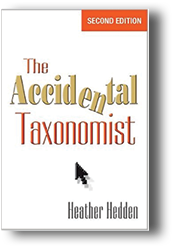 Heather Hedden. 2016. 2nd ed. Medford, NJ: Information Today, Inc. [ISBN 978-1-57387-528-8. 464 pages, including index. US$39.50 (softcover).]
Heather Hedden. 2016. 2nd ed. Medford, NJ: Information Today, Inc. [ISBN 978-1-57387-528-8. 464 pages, including index. US$39.50 (softcover).]
In his foreword to this meaty text, Joseph Busch describes The Accidental Taxonomist as “an excellent primer” (p. xiii). Hedden has provided here a text that is both practical and useful, and substantial. Many technical writers and other professionals find ourselves working in the “information science” field even though we never studied such. Here’s the missing reference.
As an indexer, I am familiar with much of what Hedden covers. The first four chapters (“What Are Taxonomies?,” “Who Are Taxonomists?,” “Creating Terms,” and “Creating Relationships”) are quick reads and review for me, but they are thorough and much appreciated. Chapter 5, “Software for Taxonomy Creation and Management,” covers the various types of software options available for creating and managing taxonomies. The taxonomy field has changed a lot since Hedden’s first edition. Thus, she covers here software not designed for creating taxonomies (such as Excel and FreeMind), dedicated taxonomy management software, single-user software (such as MultiTes), and multi-user software (such as Data Harmony). Hedden also reviews free and open source software and software with taxonomy management components.
Hedden says that one of the main purposes of a taxonomy is support of indexing as well as support of information retrieval, organization, and navigation. Chapter 6, “Taxonomies for Human Indexing,” is of keen interest to me as I anticipate indexing with a formal taxonomy, which is exactly what she covers therein. Hedden’s coverage of taxonomy structures and indexing interfaces is useful. I especially appreciate her attention to quality control.
I also found interesting her coverage of folksonomies, taxonomies created by authors or users, and her coverage of social tagging. In this age of metatags and hashtags, many of us have to incorporate input from “general folk,” and her suggestions are helpful.
Hedden also covers taxonomies for automated indexing, which includes facets, information architecture, and other aspects of interest for commercial applications. Her summary of the differences between taxonomies for human versus automated indexing is helpful. She covers additional practical applications in chapters on displays, planning, design, and implementation.
The last chapter, “Taxonomy Work and the Profession,” may be of keen interest to many, especially those in transition. I like Hedden’s honest description of taxonomy work: “The heart of being a taxonomist is dealing with concepts . . . It is neither entirely technical/mathematical nor entirely linguistic” (p. 383). In 2015, Hedden conducted a survey of self-described taxonomists from various online groups. She asked them what they enjoy and what they find challenging. The answers are telling, especially for those considering entering the field. The full survey is provided in Appendix A, and selections from the comments are included in Chapter 2. The appendices also include a detailed Glossary, Recommended Reading, and websites.
Hedden often describes herself as “long-winded” (personal email correspondence, and, most recently, at the ASI annual conference, June 18, 2016). I beg to differ. She has much to say, and it’s all good.
Pilar Wyman
Pilar Wyman, Chief Indexer at Wyman Indexing, has been writing indexes for over 25 years. She is a former STC member and current member of the American Society of Indexers (ASI). Pilar works in English, Spanish, and French in public health, clinical medicine, med-tech, and other areas of personal interest.
Restricted Access: Media, Disability, and the Politics of Participation
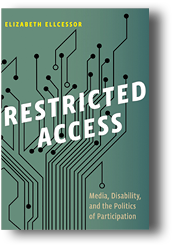 Elizabeth Ellcessor. 2016. New York, NY: New York University Press. [ISBN 978-1-4798-5343-4. 252 pages, including index. US$28.00 (softcover).]
Elizabeth Ellcessor. 2016. New York, NY: New York University Press. [ISBN 978-1-4798-5343-4. 252 pages, including index. US$28.00 (softcover).]
As an academic who researches cultural and medical communication, who is involved with various disability groups around campus and in my community, and who is the parent of a child with multiple disabilities, I know more than the average person about disability law and accommodations. Because I am intimately familiar with many of the issues that people with disabilities face when they engage with the technologies necessary for daily life, I was keen to read Elizabeth Ellcessor’s book Restricted Access: Media, Disability, and the Politics of Participation.
Restricted Access provides a detailed examination of the design and implementation of communication technologies from the perspective of a person with disabilities. Ellcessor neatly avoids the both the “medical gaze” that reduces a person with disabilities to their conditions, as well as the abled bias of viewing people without disabilities as the “default” user of the technologies. She accomplishes this through extensive interviews with people with disabilities, as well as with stakeholders working in communications, academia, software development, and government agencies (p. 14).
The main method Ellcessor used to dissect the design, or redesign, and use of technologies for people with disabilities was accomplished through “An Interrogatory Kit for the Study of Access,” designed by the author (p. 19). This “kit” contains five major tools, or themes, for analysis: regulation, form, use, content, and experience. Each chapter following the introduction develops one of these themes in detail. Although Ellcessor described why she chose the trope of the “kit” to describe her methods, and the comparison of her methods to a common schema might make her ideas more palatable to a less research-inclined audience, I found the wording off-putting because it seemed condescending to an academic audience who is familiar with these types of analyses. However, once I got past the extensive discussion of the semantics, which even went so far as to include a photograph of a more practical “kit” (p. 20), I found the author’s framework pragmatic and easy to apply.
The book’s greatest strength is the author’s knowledge and attention to detail. Ellcessor is well versed in disability law and on the major legislation that defines “equal access” for people with disabilities as well as pending legislation that could lead to further changes in disability law. Her depth of knowledge in communications and legal issues provides a rare insight into how the law has shaped the legal and ethical guidelines surrounding the design and modifications of technology for people with disabilities.
Restricted Access lived up to the heady expectations promised by its name. Ellcessor’s depth of knowledge, the breadth of her research, and the painstaking detail with which she articulates her points makes this book a must read for academics, as well as technical communicators working in the health, software fields, or Web publishing fields. This is a book that I know I will repeatedly reference, both for my own research as well as for my practical work at the university and in the community.
Nicole St. Germaine-Dilts
Nicole St. Germaine is an Assistant Professor in the Technical and Business Writing Program at Angelo State University, as well as a freelance writer and consultant. Her research interests include technical communication for a Mexican-American audience and technical communication in the health fields.
Experience Required: How to become a UX leader regardless of your role
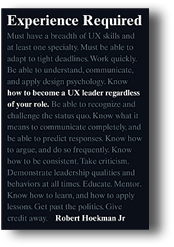 Robert Hoekman, Jr. 2016. Berkeley, CA: New Riders. [ISBN 978-0-13-439827-3. 210 pages, including index. US$29.99 (softcover).]
Robert Hoekman, Jr. 2016. Berkeley, CA: New Riders. [ISBN 978-0-13-439827-3. 210 pages, including index. US$29.99 (softcover).]
Knowing what user experience (UX) entails is only half the battle. That is, if you can really pinpoint a definition of what UX is. As Hoekman says, “‘UX design’ means everything and nothing” (p. 17). This is the journey he takes the readers on in Experience Required: How to become a UX leader regardless of your role. Hoekman begins by dispelling much of what you might think or know about UX; how it has come to be and where it originated from, the path to get there, and how to remain on top. From starting the readers off with some definitions and terms, such as wanting to be a “Unicorn” (p. 18), to what it really takes to move out of a role of simply falling in line and taking orders, to becoming a leader and directing a team, this is the definitive how-to guide.
For example, some of what Hoekman tells the readers, through several anecdotes, is that to be a successful leader, “you have to be able to accept criticism with grace” (p. 149), not “ignore the team. [But] put them to use” (p. 152), and to “master the art of learning” (p. 177).
With countless years of experience as a veteran UX strategy consultant and hundreds of articles written on the topic, Hoekman uses his own expert knowledge coupled with input from other experts in the field to round out a narrative that takes its user from the ground floor on up. He explains the way that things in the UX field are done, how they can be done better, and more specifically, how the readers can use this knowledge to better themselves as UX designers, and as a UX leader. Hoekman writes this book with several audiences in mind, and notes that designers, students, instructors, and more can all benefit.
After moving through the definitions and familiarizing the audience with the UX world, Hoekman tailors his chapters to specific qualities and skills that are necessary to understand in becoming a UX leader, such as communicating, leading, and learning. He gives examples of his own personal experiences learning these skills, and instances many readers may have experienced as well in their careers.
At the end, Hoekman leaves us with this message: “You can design your role. Your skill set. Your communication. How people react to you. How you react to situations, to people, to constraints, to changes. You get what you design for. Design to lead” (p. 201).
Jack Labriola
Jack T. Labriola is an STC student member of the Texas Tech University chapter and a Ph.D. student pursuing a technical communication and rhetoric degree. His research interests focus on UX design, usability, social media, and content strategy.
Literacy in Practice: Writing in Private, Public, and Working Lives
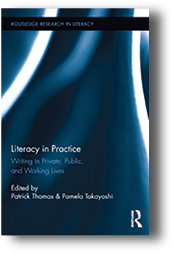 Patrick Thomas and Pamela Takayoshi, eds. 2016. New York, NY: Routledge. [ISBN 978-1-138-95120-4. 262 pages, including index. US$160.00.]
Patrick Thomas and Pamela Takayoshi, eds. 2016. New York, NY: Routledge. [ISBN 978-1-138-95120-4. 262 pages, including index. US$160.00.]
The rapid growth of powerful new communication technologies in the early 21st century has broadened the definition of literacy and given rise to a scholarly interest in the relationship between individuals’ literacy practices and their larger social and cultural contexts. In Literacy in Practice: Writing in Private, Public, and Working Lives, the editors give us 16 essays on professors’ qualitative research in the New Literacy Studies field. With small sample sizes—four of the essays focus on only a single subject—these chapters provide what feel like intimate portraits of people negotiating the communication demands of their complex worlds.
This compilation finds particular value in its diversity. The editors do well in representing a variety of ages, ethnicities, occupations, and situations. They also expand the concept of literacy beyond traditional notions of reading and writing to embrace texting, social media, workplace procedures, and even body language.
Although Thomas and Takayoshi’s introduction sets a decidedly academic tone, the direct language the essay authors use affords the reader a vivid, engaging image of each scenario. One study looks at how teens’ choices of audience impact their behavior in the language arts classroom. Of the half-dozen ninth-graders depicted in detail, one is Ivan, whose disengagement in the class discourse signifies his gang affiliation. Another chapter follows a college sophomore’s thought process as she establishes a LinkedIn profile and discerns the differences in audience and tone between that website and Facebook. Yet another study gives us an English Composition professor’s think-aloud—profanities and all—as she grades final exams with a headache.
Readers seeking a more technical examination of emerging literacy forms will appreciate the analysis of digital African American Language (DAAL), an amalgamation of African American Language and Digital Language. With no fewer than seven tables charting DAAL’s phonological and grammatical features, this article presents the patterns observed in 200 text messages and traces the language development that naturally occurs when a new technology makes the merging of multiple languages logical and expeditious.
Two additional studies expose sophisticated literacy practices in unexpected places. One researcher shows how technological innovations are increasing the amount of reading and writing involved in the daily operations of an automotive repair shop and therefore blurring the traditional line between manual and knowledge-based labor. From Mumbai comes a description of the workday routine of 18 Dabbawalas who, although often labeled illiterate because they lack formal education, are instead adept at a complex written and oral communication system that enables their business to thrive.
The relationship between literacy and empowerment is also powerfully evident in the account of a woman with multiple sclerosis who leverages her online presence to grow personally, socially, and professionally. Throughout this collection, the reader sees the editors’ point about the value of studying how people use literacy. These subjects are easy to visualize and bring to life how literacy practices impact the individual and how each individual’s literacy choices contribute to the evolution of culture in the 21st century.
Laurie Shirley Esposito
Laurie Shirley Esposito is a seasoned high school English teacher with instructional experience at all academic levels. She has also worked in publishing and freelance journalism. Laurie has a BA in English/Liberal Arts from La Salle University and a MA in Teaching of English from Teachers College, Columbia University.
The New Normal: Pressures on Technical Communication Programs in the Age of Austerity
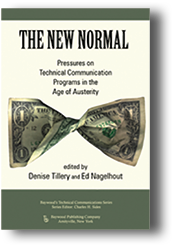 Denise Tillery and Ed Nagelhout, eds. 2016. Amityville, NY: Baywood Publishing. [ISBN 978-0-89503-914-1. 238 pages, including index. US$59.95 (softcover).]
Denise Tillery and Ed Nagelhout, eds. 2016. Amityville, NY: Baywood Publishing. [ISBN 978-0-89503-914-1. 238 pages, including index. US$59.95 (softcover).]
The New Normal: Pressures on Technical Communication Programs in the Age of Austerity is a must-read for faculty and administrators of technical communication programs in America who feel the increasing pressure from the “more with less” mantra that pervades all academia. Additionally, practitioners in geographic regions where technical communication programs are offered should read this book to better understand the nature of such programs today and think about how industry might better partner with these programs to continue a steady supply of qualified writers and editors.
As a part-time lecturer in technical communication, I’m obliquely aware of the budgetary and political constraints on the program. The New Normal helped me articulate the concerns that I was only aware of subconsciously and has given me ideas to suggest to the program director.
The editors skillfully selected chapters that represent a broad spectrum of technical communication programs. In this single volume, they represent graduate and undergraduate programs, new programs and existing ones, minors, certificates, online and face-to-face programs, state universities, and a small liberal arts college.
The authors treat the readers to a refreshing variety of topics from provocative perspectives. For example, author Dirk Remley analyzes the balance between instructor autonomy and consistency in the face of online learning management platforms. In “Googling Academe,” the authors lament that many universities are cutting costs by outsourcing their information technology (IT) infrastructure to corporations like Google and Microsoft—and the troubling conflict between end-user agreements and intellectual property rights—and the disappearance of personal Web space that the program relied on for student Web projects.
Not only do the authors identify several concerns about sustaining and growing technical communication programs, but they offer specific advice. In “Frugal Realities,” the authors outline specific assignments for creating a “hacker pedagogy” and creating more resourceful students. In “Service-eLearning in the Online Classroom,” the authors outline specific program outcomes. In “Development in Technical Writing Programs,” the authors explain how to achieve a manageable work-life balance by breaking down the workload (and limiting the amount of time spent on each task)—with an example semester schedule.
Surprisingly, MOOCs (Massive Open Online Courses) did not factor as a major concern in this book. MOOCs are only mentioned at the end of the first chapter, which leads one to wonder if the attention they garnered a few years ago is really of no great concern in the age of austerity.
My only criticism is that many of the authors outline the brutality of salary cuts, hiring freezes, and layoffs to set the stage for how their programs adapted under pressure. While the severity of these demoralizing events cannot be understated and deserve attention, the reader may find it tedious to read without feeling like this is Chicken Soup for the Professor’s Soul. Admittedly, these points are foundational to the many splendid solutions the authors recommend.
Michael Opsteegh
Michael Opsteegh is an STC Senior Member and a technical writer in the software and financial services industries since 2004. He is a lecturer in the technical communication program at Cal State Long Beach. Michael holds a master’s degree in English and is a Certified Technical Professional Communicator (CPTC).
International Virtual Teams: Engineering Global Success
 Pam Estes Brewer. 2015. Piscataway, NJ: IEEE Press. [ISBN 978-1-118-33900-8. 222 pages, including index. US$49.95 (softcover).]
Pam Estes Brewer. 2015. Piscataway, NJ: IEEE Press. [ISBN 978-1-118-33900-8. 222 pages, including index. US$49.95 (softcover).]
Dr. Brewer’s book, International Virtual Teams: Engineering Global Success, builds on her earlier research on this topic and does a good job of combining academic research with practical tips for managing virtual teams.
The book’s layout makes it easy to pull out core concepts, case studies, and guidelines. Chapter 9 provides instructor guidelines for designing training, though the content is more oriented toward a university classroom than corporate training. This content can easily be adapted to a corporate training environment.
Throughout International Virtual Teams, Dr. Brewer reinforces the concepts and guidelines with data in tabular and graphical form, making it easy to see how the concepts relate back to the data. For those of us who regularly manage or work on virtual teams, none of these findings are a surprise. For example, miscommunication occurs at about the same frequency with multicultural teams, but the consequences of that miscommunication are higher.
Like many books on teaming, her guidelines seem simple and obvious, but as anyone who works on teams knows, the devil is in the details, and this is particularly true for virtual teams. Her points are well taken about metacommunication early in the team-building phase and making sure you allow time for social communication and for understanding the flow of each person’s work day. Forgetting to do these basics during the initial project setup will cost you time and money throughout the project as you battle unspoken expectations and greater misunderstanding.
My one criticism is that she implies that virtual teaming is a new thing. While the technology to support virtual teams has improved exponentially in the past 25 years, virtual teaming has been around for a long time, particularly in the technical fields. (ARPANET, for example, was an effort to facilitate data communication across a network of dispersed scientists.)
If you need data to convince your management to invest more time and training in developing and managing virtual teams, International Virtual Teams can help you present the data. You can use the case studies and core concepts to create an effective presentation to management.
Katherine (Kit) Brown-Hoekstra
Katherine Brown-Hoekstra, of Comgenesis, LLC, is an STC Fellow, speaks at conferences worldwide, and has authored many articles on various topics related to technical communication and internationalization. She has a background in life sciences and more than 25 years of experience. She also coauthored a book on managing virtual teams. Her blog is www.pangaeapapers.com.
The International History of Communication Study
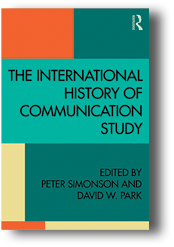 Peter Simonson and David W. Park, eds. 2016. New York, New York: Routledge. [ISBN 978-1-138-84603-6. 528 pages, including index. US$44.95 (softcover).]
Peter Simonson and David W. Park, eds. 2016. New York, New York: Routledge. [ISBN 978-1-138-84603-6. 528 pages, including index. US$44.95 (softcover).]
Many disciplines have contributed to the history of technical communication from psycholinguistics to sociology to behavioral psychology. A major contributor has been from journalism through the sub-specialty of technical journalism. Just as technical communication has broadened from technical writing (and technical journalism) to what we study today by adapting research results from other disciplines, so too has journalism. Students now study communication, including media studies, mass communication, and speech communication. Simonson and Park have assembled an anthology of 23 essays from 34 authors on the history of this discipline in The International History of Communication Study and divides them into 5 groups based on geographical regions: Europe, North America, Latin America, Asia, and Africa and the Middle East. They introduce each group with an overview of the history of communication studies in the area covered by the essays.
The goal of the essays is to explain how communication research may be useful for scholars and graduate students in communication, media, and journalistic studies through showing how they interact with and influence each geographic area. The focus is on research after World War II and the essays have a basic pattern of discussing early researchers that helped the studies become important and then a general history of communication studies. The three fields that the essays cover for their geographic area are mass communication research/media studies, journalism and newspaper studies, and speech communication studies (that receive the least amount of coverage). All essays are written in English.
The collection’s strengths lie in that it presents the history of communication in a variety of countries, and that the essays are thorough literature reviews of that history. Another strength that helps the reader understand how communication study has evolved is the comparisons between and among countries.
A weakness I find in the essays is that they do not discuss whether or not a particular view point is taught. And this approach could prove important in countries with strong central governments. How are students, in this example, to avoid such bias and retain neutrality? In literary classes, the teacher often announces and takes a specific interpretation viewpoint. For example, teachers may have their students read a number of novels for their mythic content.
For technical communicators interested in how these communication studies have developed and how they may be related to influences on technical communication, they will find the collection valuable even though none of the authors really discuss technical communication and its relationship to journalism, media studies, and speech communication. Those wanting an insight into how communication studies influence cross-cultural communication will also find the collection valuable when read from a cultural influence viewpoint.
So, while the collection has limited value for technical communicators, it is only when comparing how communication, as the editors define it, can influence technical communication.
Tom Warren
Tom Warren is an STC Fellow, Jay R. Gould Award for Excellence recipient, and professor emeritus of English (technical writing) at Oklahoma State University, where he established the BA, MA, and PhD technical writing programs. Past president of INTECOM, he served as guest professor at the University of Paderborn, Germany.
Communication and Emerging Media: What’s Trending Now
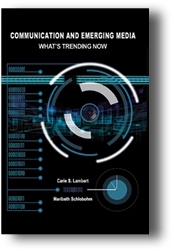 Carie S. Lambert and Maribeth Schlobohm. 2015. Dubuque, IA: Kendall Hunt Publishing. [ISBN 978-1-4652-7459-5. 340 pages. US$52.50 (softcover).]
Carie S. Lambert and Maribeth Schlobohm. 2015. Dubuque, IA: Kendall Hunt Publishing. [ISBN 978-1-4652-7459-5. 340 pages. US$52.50 (softcover).]
Impressive is the word that came to mind when I saw the write up describing authors Carie Lambert and Maribeth Schlobohm. Schlobohm works as a teacher of professional and technical writing at the University of Texas. Lambert holds a PhD in technical communication and rhetoric from Texas Tech and also teaches at the University of Texas.
Together these two developed 10 impressive chapters in Communication and Emerging Media: What’s Trending Now. The topics are a grab bag on the general topic of communication and emerging technologies. What ties the chapters together is each writer’s chapter having a background of work at the University of Texas. Here is a glimpse at the topics with a focus on how emerging media influences communication: mobile as a force in the future, social communication, marketing communication, health communication, education and learning, cyberlaw, and ethics.
Health communication seemed to me an especially interesting topic. The authors of that chapter note if you Google medicine you will find over 80 million Web pages in about 0.32 seconds. If you Google medicine in about 0.28 seconds, you will see over 1 million Web pages. And the topic is not just big on the Web. It is big on Twitter, Facebook, Pinterest, Tumblr, and the like. Government websites also exist with examples including Center for Disease Control, Health.gov, Medicare.gov, National Institute of Health.
Emerging media becomes an important tool here not just to disseminate information but also for fundraising as with the recent ice bucket challenge raising money for ALS (amyotrophic lateral sclerosis).
What does the future hold? Could it be the ability to print an organ or personalized drugs? Will we continue with trends such as booking online and electronic medical records? Will telemedicine continue to improve and serve rural areas?
There are pros and cons to the use of emerging media regarding medicine. The related chapter covers some and provides great food for thought. This holds true for the other sections of Communication and Emerging Media. If you have an interest in emerging media and education, you should find the book of interest. If you are a teacher, this book might be a great pick for your students.
Jeanette Evans
Jeanette Evans is an STC Associate Fellow and active in the NEO community, currently serving on the newsletter committee. She holds an MS in technical communication management from Mercer University. Jeanette recently published an article, “Emerging Technologies: Where We Have Been and Where We Are Going” in STC’s Intercom magazine.
Organizing Ideas: The Key to Effective Communication
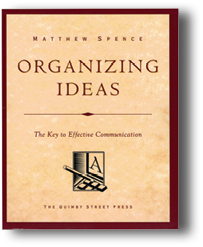 Matthew Spence. 2015. Portland, OR: The Quimby Street Press. [ISBN 978-1-495-98493-8. 198 pages, including index. US$20.00 (softcover).]
Matthew Spence. 2015. Portland, OR: The Quimby Street Press. [ISBN 978-1-495-98493-8. 198 pages, including index. US$20.00 (softcover).]
Spence describes Organizing Ideas: The Key to Effective Communication as a cookbook, and this is true. It is a collection of recipes for producing effective business writing. But just as a well-written cookbook teaches the reader essential kitchen skills, using the Spence & Company guide to decision-oriented communication will teach the writer essential business writing skills. I recommend adding it to your reference bookshelf.
This book is well-written, presents concepts clearly and simply, and has a layout that is unfussy, with just enough formatting to skim for major points in each chapter. The chapters build on the skill learned in the previous chapter.
Throughout the book, attention is paid to the usual best practices for business writing. The Spence method endorses plain language, simple sentence structures, and signposting important sections. It recommends putting technical details and databases into attachments instead of the document’s body.
The Spence method uses the disciplines of rhetoric. The author argues that all business writing should persuade the reader to make a decision or to take action. The Spence & Company method combines three rhetorical tools of persuasion: Logos (appeal to logic or reason); Ethos (appeal to character or trust); and Pathos (appeal to motivation or inspiration).
Reader needs are a frequent checkpoint through the guide. The Reader Profile is critical to this process as it identifies the primary and secondary decision-makers or readers.
Organizing Ideas uses the same structure for all business communications, customizing the structure to the target reader and communication type. The framework always has an Opening Statement (Why are you writing this document? What is your document about? How will you discuss your subject? What decision or action do you recommend?), a Body (all the data, issues, and conclusions that support your Recommendation), and a Summing Up (restate your position; recap your conclusion; repeat your recommendations.)
Worksheets are key tools in the Spence & Company method. There are worksheets for every type of business communication, from email and texting, through long and short memos and reports to slide deck presentations. Every worksheet is an outline of questions and answers (Q & A). Starting with the major sections—Opening Statement, Body, Summing Up— the writer works through the Q & A to gather the information needed for the communication. Instead of starting with a blank page, a writer using a worksheet can jump-start a document from outline to first draft.
A companion book, Business Writing: The Good, the Bad, and the Ugly, provides every type of blank worksheet including dozens of before and after sample documents that illustrate how the Spence method will improve the clarity of any communication.
I adopted the email worksheet; it works! Responses are arriving sooner with better information. This is a useful, helpful book for business writers and technical communicators.
Marcia Shannon
Marcia Shannon is an STC member and newly STC-certified writer (CPTC-Foundation). Her more than 30 years of business experience cover IT, mortgage, banking, and insurance. Marcia has written and taught procedures as well as provided user support. Currently, she writes and edits procedures and job aids, and coaches non-writer co-workers.
Muse of Fire: Storytelling & The Art of Science Communication
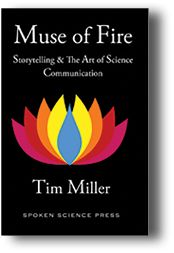 Tim Miller. 2015. Manchester, CT: Spoken Science Press. [ISBN 978-0-996-94920-0. 220 pages. US$15.00 (softcover).]
Tim Miller. 2015. Manchester, CT: Spoken Science Press. [ISBN 978-0-996-94920-0. 220 pages. US$15.00 (softcover).]
Whether you are a working scientist weighing in on matters of great public importance, or a researcher trying to explain your findings to editors or peers, your success will depend not just on what you know but on how well you communicate what you know.
Unfortunately, many scientists have a reputation for being poor communicators.
Tim Miller, a science communication consultant at the Alan Alda Center for Communicating Science at Stony Brook University, hopes to improve the situation. With Muse of Fire: Storytelling & The Art of Science Communication, he describes the various communication challenges and opportunities faced by working scientists and gives solid, practical advice for addressing them.
Miller traces poor science communication to a number of causes—failing to properly estimate the audience, a tendency to attribute confusion to the difficulty of the subject matter rather that to how it is presented, following poor models from seniors—and more generally to a lack of basic communication training in science curricula.
When faced with a communication opportunity, many scientists start by asking themselves “What should I talk about?” and then proceed to think up things to say about whatever holds their interest at the moment. This approach often leads to muddled presentations that are hard to follow.
Instead, Miller recommends the following strategy: Choose your impact; identify your audience; craft your message. For example, you might want to convince educated lay people to support a position on, say, global warming, legislators to support funding, or youngsters that science is interesting and would make a good career. After both your desired impact and your audience are clear in your mind, use them as guides to selecting your material and crafting your message.
Miller holds that another key point that is often missed by scientists is that most communication works best when framed as a story. Miller covers basic narrative structure—a protagonist who wants to accomplish something important, faces obstacles, and succeeds (or fails) to overcome them—and shows how narrative structure and techniques apply to science communication. Further, he argues, framing your message as a narrative serves to engage your audience and helps it understand both the details and importance of your presentation.
Moving beyond organization, Miller covers the mechanics of presenting and offers valuable, practical advice on handling such things as giving slide presentations, designing posters, making videos, issuing press releases, and making use of online tools and social media.
Miller wraps up by offering strategies and guidance for handling thorny issues of public engagement and controversy such as those surrounding evolution and global warming.
Whether you are just starting your career or are an old hand seeking to better match your communication skills with your scientific expertise, Muse of Fire has much to offer.
Patrick Lufkin
Patrick Lufkin is an STC Associate Fellow with experience in computer documentation, newsletter production, and public relations. He reads widely in science, history, and current affairs, as well as on writing and editing. He chairs the Gordon Scholarship for technical communication and co-chairs the Northern California technical communication competition.
The Graphic Design Idea Book: Inspiration from 50 Masters
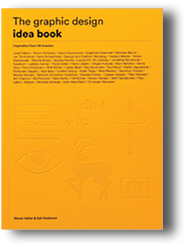 Stephen Heller and Gail Anderson. 2016. London, UK: Laurence King Publishing Ltd. [ISBN 978-1-78067-756-9. 128 pages, including index. US$17.95 (softcover).]
Stephen Heller and Gail Anderson. 2016. London, UK: Laurence King Publishing Ltd. [ISBN 978-1-78067-756-9. 128 pages, including index. US$17.95 (softcover).]
The Graphic Design Idea Book: Inspiration from 50 Masters is designed to showcase a combination of themes, ideas, and styles used in graphic design. It tours artwork and design starting with the mid-20th century and continuing up to recent times. As expected of a graphic design book, there are illustrations paired with every concept in the book.
Heller and Anderson took the approach that the best way to convey graphic design is to create a book where the works of graphic design leaders illustrate concepts to the reader. First, the authors created thematic groups such as “Experiment with design” and “Communicate a message” and placed the artwork and styles into each group. Each grouping contain several concepts, such as “white space,” “collage,” and “mood.” Every conceptual section contains a list of the artists featured in that section but does not contain an explanation as to why the grouping was created, or how the concepts and artists were chosen for that group. In turn, each concept is represented by a two-page spread featuring one page of commentary and one page of illustration by an artist whose work exemplifies the concept. For example, in the “Play with type and image” group, the concept of tromp l’oeil is first explained. The descriptive text explains the history of how tromp l’oeil evolved and how modern advertisements take advantage of such optical illusions to attract attention to their products. On the opposite page is the illustration of a 1962 shoe advertisement. The ad features a bus where the ad banner appears where the passenger’s legs and feet would be, giving the illusion that you are looking through the side of the bus at their shoes. The whole book follows this pattern so you can easily flip through looking for visual ideas and then read an explanation of the displayed technique.
Overall, The Graphic Design Idea Book is a fun introduction to the art of graphic design. The prose is clean and easy to read, and the illustrations are well-paired with their associated themes. It is not heavy or authoritative and is intended to both clarify ideas and to inspire artists. If you are looking for a good place to start with graphic design, this book is a good choice. While it won’t teach you to be an artist, it can help focus your existing artistic skills into established styles. Therefore, I recommend The Graphic Design Idea Book to anyone interested in learning how artwork can be used for commercial purposes and to anyone interested in a survey in the past 100 years of graphic art.
Timothy Esposito
Timothy Esposito is an STC Associate Fellow with over 15 years of technical communication experience. He is currently president of the STC Philadelphia Metro Chapter. Before becoming president, Timothy was chapter VP, treasurer, webmaster, and scholarship manager.
Research for Designers: A Guide to Methods and Practice
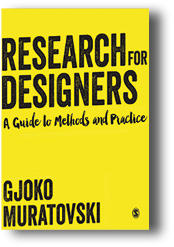 Gjoko Muratovski. 2016. London, England: Sage. [ISBN 978-1-4462-7514-6. 242 pages, plus index. US$41.00 (softcover).]
Gjoko Muratovski. 2016. London, England: Sage. [ISBN 978-1-4462-7514-6. 242 pages, plus index. US$41.00 (softcover).]
Research for Designers: A Guide to Methods and Practice targets design students as well as professional designers who want to incorporate research into their design process. Although aimed specifically at designers, the book can also serve as a practical introduction to basic research methodologies for any member of a design team, including developers, technical writers, and management.
Muratovski argues that design has traditionally been seen as an artistic practice “driven by intuition” rather than a practical research-based approach to problems; in today’s market, however, design is increasingly interdisciplinary and designers must learn new skills to compete (p. 10). Chapters 1 and 2 briefly introduce Muratovski’s approach and provide an overview of the historical role of design and the benefits and challenges of cross-disciplinary design research. Chapter 3 explains “Research Essentials,” such as determining a research problem and developing a research question. The remaining chapters introduce various research types (qualitative, quantitative, visual, and applied). Finally, the book explains how to present your findings and craft a design brief or report.
Research for Designers is well organized and broken into manageable sections and subsections that make it easy to find specific information; numbered lists, bullet points, illustrations, and real-world examples make the methodologies easily digestible. A brief summary follows each chapter. As an introductory textbook, Muratovski covers a wide breadth of research types; because of this, it sometimes lacks depth and specificity in certain areas.
Some of the book’s most useful content applies across the design team. If the team is new to incorporating design research into its process, Chapter 3 will prove useful. Muratovski emphasizes the need to formulate a clear research statement that everyone—expert or not—can understand: “If you cannot explain in simple terms what the problem is that you are trying to address, the chances are that you still do not have a good understanding of what the problem is” (p. 29). This chapter also provides an overview of the research methodologies and criteria for applying each type to your research problem. Qualitative research, for example, is best when you are dealing with “unfamiliar situations or issues,” in other words, understanding the complexity of the problem, while quantitative research simplifies problems and is best applied for testing an existing theory rather than formulating a new one (p. 37). Muratovski also recommends combining multiple methodologies depending on your specific research question.
The author’s chapters on research methodologies offered numbered steps that outline the process from formulating the topic to presenting findings. Although not in-depth enough to provide a comprehensive plan for large-scale or academic research, this bare-bones approach is sufficient for small-scale commercial or educational projects.
I would recommend Research for Designers to anyone looking to incorporate research into their development process for the first time. It is a well-organized introduction to research planning and methodologies that can be implemented by a cross-disciplinary design team.
Bonnie Shamp Winstel
Bonnie J. Shamp Winstel is an STC member and a technical writer for a small software company in Huntsville, Alabama. She received her master’s degree in English and Technical Communication at the University of Alabama-Huntsville in May 2013.
Photoshop Tricks for Designers: How to Create Bada$$ Effects in Photoshop
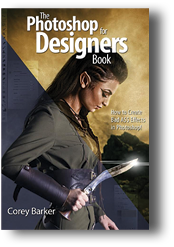 Corey Barker. 2016. Berkeley, CA: Peachpit Press. [ISBN 978-0-13-438657-7. 182 pages, including index. US$29.99 (softcover).]
Corey Barker. 2016. Berkeley, CA: Peachpit Press. [ISBN 978-0-13-438657-7. 182 pages, including index. US$29.99 (softcover).]
I always marveled at my company’s graphic designers, “You are magicians!” How did they come up with those fantastic ideas for our book designs? Above all, what magic did they conjure up to bring those ideas to life?
Photoshop Hall of Famer Corey Barker has an answer: they knew the kinds of tricks that he can teach you to make you, too, a Photoshop wizard. He assumes that you have at least intermediate expertise in Photoshop. If, for example, you don’t know how to “apply a Drop Shadow layer style” (p. 5), you’re not the intended audience. You might learn something by attempting a few steps, but you’ll find yourself continually baffled and frustrated. You know you indeed have the necessary skillset if you’re one of the “We” in statements like “We all know that you can bevel text in Photoshop using layer styles” (p. 170). If this is you, you have here a cookbook of instruction and inspiration that will send you into creative Nirvana.
The book is not cumulative in structure. Rather, you have 36 illustrated projects in nine chapters organized by general type of effect: type, commercial, graphic, photo, texture, light, color, Hollywood-style, and 3D. You can launch into any project without looking at other pages, although Barker cross-references related information in other projects.
The projects are nothing short of astounding. My favorites are creating double exposures to turn cityscapes into parts of the body, turning photos into brushes used to blend colors, and applying texture to images to create 3D text.
Barker heightens the inspiration by continually using words like cool and clever, and many steps are “tricks”—appropriate for the creator of the heavily attended Down & Dirty Tricks seminars. He aims to teach you that “You can achieve a lot more than you think, once you know what you can do” (p. 163). Beyond this, he wants you to experiment on your own, varying the choice of filters and slider settings and devising your own “tricks.”
The index, which points mostly to Photoshop features, is helpful in its organization and depth. Helpful also are the many downloadable supplementary files: pictures (JPEGs and TIFFs), brushes and brush toolsets, and Photoshop PSD files. You can also use your own files.
Are you a working designer, artist, photographer, or even serious hobbyist who wants to use Photoshop in ways you never dreamed of? If you are, this is your book.
Avon J. Murphy
Avon J. Murphy is a technical editor in western Washington. A retired college professor and government writer, he is an STC Fellow, a contractor, and principal in Murphy Editing and Writing Services, specializing in computer and Web technologies. Avon served as book review editor for Technical Communication for 17 years.

